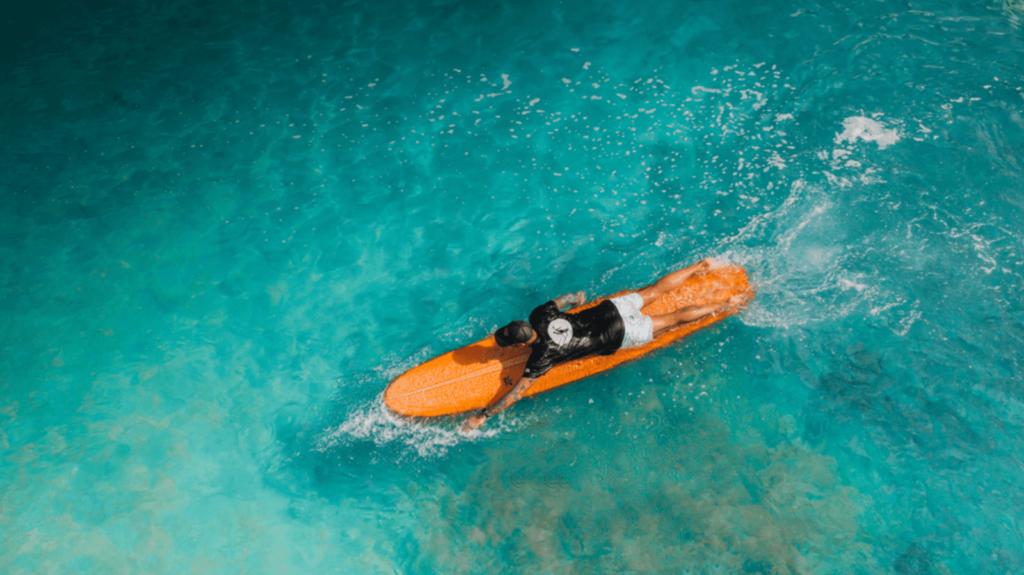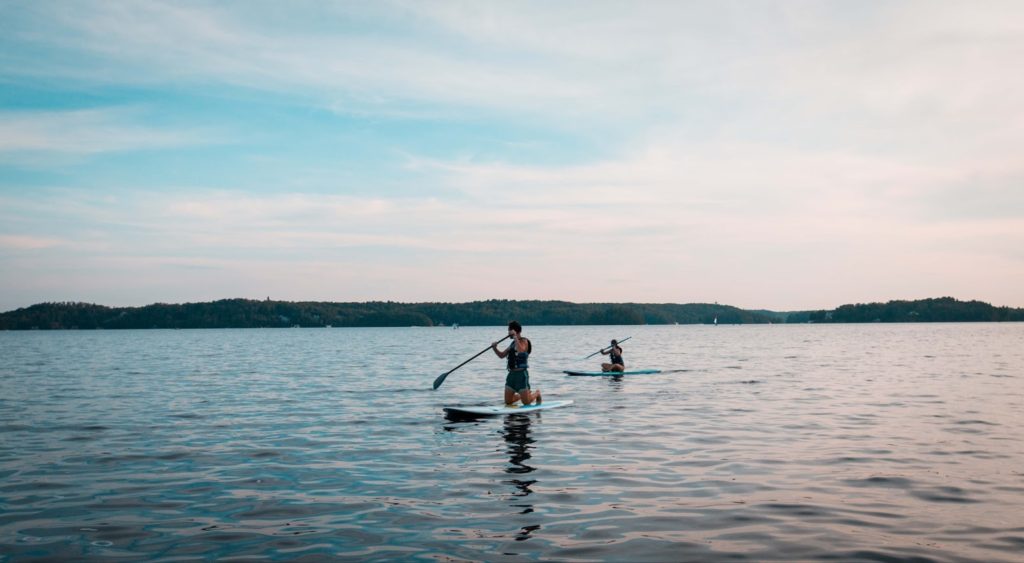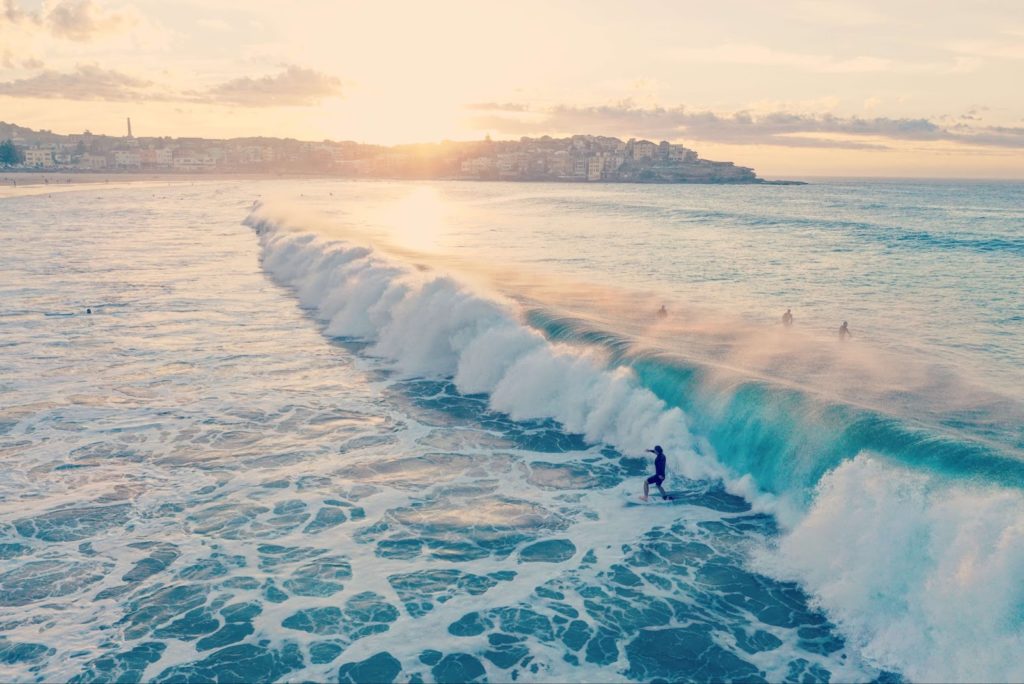Who doesn’t love paddleboarding? With how easy it is to get the hang of, paddleboarding is an enjoyable activity for the entire family. If you have some experience, rather than just cruising through the water on a paddleboard, learn how to surf the tide. To help you learn, let’s look at how to paddleboard in waves like a pro.
Instructions for Catching Waves on a Stand Up Paddle Board

If you’re new to catching waves with your board, you need to learn the basic steps for keeping your balance and ensuring that you ride against the waves comfortably. In this section, let’s cover the best way to use your paddleboard to catch waves.
Choose the Right Paddleboard and Equipment
The first step to being able to ride the waves correctly is to have all of the right paddleboards. Paddleboards come in different sizes, shapes, and volumes, meaning it can be challenging to choose which one performs the best for surfing.
One type of board suitable for this activity is the surf paddleboard. A surf paddleboard is smaller and has a more narrow width at each end of the board, helping with maneuverability. Regarding length, a surf paddleboard is typically 9’ – 11’ in size with a narrow nose.
Depending on your experience level, touring paddle boards may also be suitable. They are 11′ – 14′ in length and a little more complex to operate at the beginning. However, more practice should enable you to ride the waves smoothly.
Paddle Out to the Waves on Your Paddleboard

The first step to wave paddle surfing is to paddle out to the ocean. Ensure that you have your paddle securely by laying it on top of the board and connecting your paddle board to your lower leg using a paddleboard leash.
Lay down your torso so that it is parallel to the board. You should be lying forwards so you can use your hands to paddle toward the wave. When lying down, put your left hand in front of you and push downwards and backward against the water.
Next, perform the same action with your right hand. Continue by alternating your hands until you reach closer to the wave.
Hold Your Paddle and Sit Up on Your Knees

Once you get closer to the waves, you can begin to stand up by first grasping the middle of your paddle tightly using one hand. Put the other hand on the board to stabilize yourself and slowly bring your chest upwards until you can comfortably place your knee on the board.
If you find it challenging to maintain your balance, you can lower your body again to the lying down in your front position. Otherwise, lift your other leg so both knees are on the board.
Stand Up on Your Paddleboard
Next, stand up on your paddleboard. Bend your torso forward and put both hands on the paddleboard, so both your hands and knees should touch the board. Keep your balance using your hands while you slowly begin standing with one foot.
After placing your foot on the paddleboard, remove one hand and slowly stand up. When you place your foot down, it should be on the middle of the board so that your weight doesn’t tip the balance and cause you to fall.
Use Your Paddle to Put Yourself in the Right Position
Place both hands on the paddle, and use forward strokes to put yourself in the correct position. For beginners, the front of your board should face the same direction as the wave. Depending on the board you use, you may be able to turn around and wait for the tide to hit your board.
Switch to a Surfing Stance

When the wave almost hits your board, turn on your side and switch to a surfing position. The surf stance involves you putting one foot in front of the other with space between your feet. Your toes should be facing forwards and your knees bent.
While you are in the surfing position, use your paddle to paddle against the wave. Paddling hard will help you to maintain your stance and allow you to propel yourself forwards. Performing forward strokes can also help you to speed up.
Ride the Full Wave
You can perform this step if the wave is long and relatively tall. Use your paddle to turn your board so its length is parallel to the tide. Turn your body so that your torso faces the same way as the wave.
Lower your knees and place both hands on the middle of the paddle. Place the paddle blade on the water to keep your board stable. Continue until you reach the end of the wave.
What to Do When You Wipe Out

If the tide ends up too strong or you lose your balance, you must fall in the right direction and use the proper method of falling. Do not ever dive head first into the sea. It will hurt and can potentially lead to injuries, especially in shallow waters.
Fall feet first into the water or lower your waist if you can feel yourself falling. It will protect you and help minimize injuries to your upper body.
Steer clear of your paddleboard while you are falling. Even an inflatable paddleboard can hurt if you bash into it, so protect your head and neck by covering those areas with your arms. For beginners, consider wearing a surfing helmet to help you keep your peace of mind.
Once you are underwater, head to the surface slowly. Continue protecting your head to prevent it from hitting your board. Make sure you watch out in case more waves come your way.
Tips for Paddle Surfing Safely
Before wave paddle surfing, ensure you understand how to perform the activity safely.
Ideal Conditions for Wave Surfing

To ride the waves safely, you must ensure that the weather and wave strength meet the right conditions. Wave paddle surfing requires milder waves that are not too weak or too tall. Before heading to the beach, check the weather and try to find out the strength of the tide.
Do not attempt to go paddle surfing during times of powerful winds or waves. For beginners, It is never a good idea to ride waves that are too large or too powerful, even if you have a pro paddle boarder nearby. When paddling individually, it becomes more difficult for you to move your board or keep your balance.
Paddle Away From Other People

To paddle surf safely, ensure you leave enough space between yourself and other beach goers. Try to go somewhere with fewer people because if you end up losing your balance, it won’t implicate others.
After riding the wave, it can propel you toward the beach. Ensure that you pay attention and do not let the tide take you to the shore. Swimmers, sunbathers, or other people are unlikely to be paying you much attention, so navigate your board to avoid them.
Learn Surf Etiquette
Learning the standard surfing etiquette is essential before heading out to the ocean. Not only does it prevent you from causing any issues with other surfers, but it can also help keep you and the people around you safe.
One part of surf etiquette is to know who has the right of way. Even if you have a paddle, do not attempt to cut someone off or move into a better position in someone’s way if they are already riding the wave or have been waiting for much longer.
Conclusion
Wave paddle surfing may be tricky for some people, but it is so much fun once you learn how to ride the waves safely. If you are a beginner, consider following the instructions above to help you paddleboard through the waves.
Frequently asked Questions
What Wave Size Is Best for Paddleboarding Beginners?
Beginners who have minimal experience with wave surfing or paddle boards should start by riding small waves about 1 to 2 feet in height. Smaller waves are more manageable to navigate against and enable beginners to practice on reasonably calmer waters.
Do I Need a Paddleboard Leash?
A paddleboard leash is incredibly convenient for helping you stick to your board if you lose your balance. It is highly beneficial and can help you locate your board if you fall and prevent it from floating far away, which may implicate others.
Do I Need a Specific Type of Paddle to Go Wave Paddle Surfing?
Paddles can differ in material, handle length, and blade size. While you do not necessarily need to get a specific type of paddle, choosing the right blade can help you quickly maneuver your board.
A back-angle blade is a good start as it enables you to perform more powerful strokes. Back angle blades are narrow and long, which can also help you quickly move your board on top of the waves.
